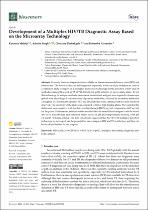 ResearchSpace
ResearchSpace
Development of a multiplex HIV/TB diagnostic assay based on the microarray technology
JavaScript is disabled for your browser. Some features of this site may not work without it.
- ResearchSpace
- →
- Research Publications/Outputs
- →
- Journal Articles
- →
- View Item
| dc.contributor.author |
Malatji, Kanyane

|
|
| dc.contributor.author |
Singh, Advaita A

|
|
| dc.contributor.author |
Thobakgale, C

|
|
| dc.contributor.author |
Alexandre, Kabamba

|
|
| dc.date.accessioned | 2024-03-01T08:57:20Z | |
| dc.date.available | 2024-03-01T08:57:20Z | |
| dc.date.issued | 2023-09 | |
| dc.identifier.citation | Malatji, K., Singh, A.A., Thobakgale, C. & Alexandre, K. 2023. Development of a multiplex HIV/TB diagnostic assay based on the microarray technology. <i>Biosensors,9(3).</i> http://hdl.handle.net/10204/13612 | en_ZA |
| dc.identifier.issn | 2079-6374 | |
| dc.identifier.uri | https://doi.org/10.3390/bios13090894 | |
| dc.identifier.uri | http://hdl.handle.net/10204/13612 | |
| dc.description.abstract | Currently there are diagnostic tests available for human immunodeficiency virus (HIV) and tuberculosis (TB); however, they are still diagnosed separately, which can delay treatment in cases of co-infection. Here we report on a multiplex microarray technology for the detection of HIV and TB antibodies using p24 as well as TB CFP10, ESAT6 and pstS1 antigens on epoxy-silane slides. To test this technology for antigen-antibody interactions, immobilized antigens were exposed to human sera spiked with physiological concentrations of primary antibodies, followed by secondary antibodies conjugated to a fluorescent reporter. HIV and TB antibodies were captured with no cross-reactivity observed. The sensitivity of the slides was compared to that of high-binding plates. We found that the slides were more sensitive, with the detection limit being 0.000954 µg/mL compared to 4.637 µg/mL for the plates. Furthermore, stability studies revealed that the immobilized antigens could be stored dry for at least 90 days and remained stable across all pH and temperatures assessed, with pH 7.4 and 25 °C being optimal. The data collectively suggested that the HIV/TB multiplex detection technology we developed has the potential for use to diagnose HIV and TB co-infection, and thus can be developed further for the purpose. | en_US |
| dc.format | Fulltext | en_US |
| dc.language.iso | en | en_US |
| dc.relation.uri | https://pubmed.ncbi.nlm.nih.gov/37754128/ | en_US |
| dc.source | Biosensors,9(3) | en_US |
| dc.subject | Antibody | en_US |
| dc.subject | Antigen | en_US |
| dc.subject | Diagnosis | en_US |
| dc.subject | HIV-1 p24 | en_US |
| dc.subject | Multiplex microarray | en_US |
| dc.subject | M.tb CFP10 | en_US |
| dc.subject | M.tb ESAT6 | en_US |
| dc.subject | M.tb pstS1 | en_US |
| dc.title | Development of a multiplex HIV/TB diagnostic assay based on the microarray technology | en_US |
| dc.type | Article | en_US |
| dc.description.pages | 18 | en_US |
| dc.description.note | Copyright: © 2023 by the authors. Licensee MDPI, Basel, Switzerland. This article is an open access article distributed under the terms and conditions of the Creative Commons Attribution (CC BY) license (https://creativecommons.org/licenses/by/4.0/) | en_US |
| dc.description.cluster | Next Generation Health | en_US |
| dc.description.cluster | Chemicals | en_US |
| dc.description.impactarea | Array Print Compan Diagnostics | en_US |
| dc.description.impactarea | BT: Technology Demonstration | en_US |
| dc.identifier.apacitation | Malatji, K., Singh, A. A., Thobakgale, C., & Alexandre, K. (2023). Development of a multiplex HIV/TB diagnostic assay based on the microarray technology. <i>Biosensors,9(3)</i>, http://hdl.handle.net/10204/13612 | en_ZA |
| dc.identifier.chicagocitation | Malatji, Kanyane, Advaita A Singh, C Thobakgale, and Kabamba Alexandre "Development of a multiplex HIV/TB diagnostic assay based on the microarray technology." <i>Biosensors,9(3)</i> (2023) http://hdl.handle.net/10204/13612 | en_ZA |
| dc.identifier.vancouvercitation | Malatji K, Singh AA, Thobakgale C, Alexandre K. Development of a multiplex HIV/TB diagnostic assay based on the microarray technology. Biosensors,9(3). 2023; http://hdl.handle.net/10204/13612. | en_ZA |
| dc.identifier.ris | TY - Article AU - Malatji, Kanyane AU - Singh, Advaita A AU - Thobakgale, C AU - Alexandre, Kabamba AB - Currently there are diagnostic tests available for human immunodeficiency virus (HIV) and tuberculosis (TB); however, they are still diagnosed separately, which can delay treatment in cases of co-infection. Here we report on a multiplex microarray technology for the detection of HIV and TB antibodies using p24 as well as TB CFP10, ESAT6 and pstS1 antigens on epoxy-silane slides. To test this technology for antigen-antibody interactions, immobilized antigens were exposed to human sera spiked with physiological concentrations of primary antibodies, followed by secondary antibodies conjugated to a fluorescent reporter. HIV and TB antibodies were captured with no cross-reactivity observed. The sensitivity of the slides was compared to that of high-binding plates. We found that the slides were more sensitive, with the detection limit being 0.000954 µg/mL compared to 4.637 µg/mL for the plates. Furthermore, stability studies revealed that the immobilized antigens could be stored dry for at least 90 days and remained stable across all pH and temperatures assessed, with pH 7.4 and 25 °C being optimal. The data collectively suggested that the HIV/TB multiplex detection technology we developed has the potential for use to diagnose HIV and TB co-infection, and thus can be developed further for the purpose. DA - 2023-09 DB - ResearchSpace DP - CSIR J1 - Biosensors,9(3) KW - Antibody KW - Antigen KW - Diagnosis KW - HIV-1 p24 KW - Multiplex microarray KW - M.tb CFP10 KW - M.tb ESAT6 KW - M.tb pstS1 LK - https://researchspace.csir.co.za PY - 2023 SM - 2079-6374 T1 - Development of a multiplex HIV/TB diagnostic assay based on the microarray technology TI - Development of a multiplex HIV/TB diagnostic assay based on the microarray technology UR - http://hdl.handle.net/10204/13612 ER - | en_ZA |
| dc.identifier.worklist | 27175 | en_US |
| dc.identifier.worklist | 27386 | en_US |





